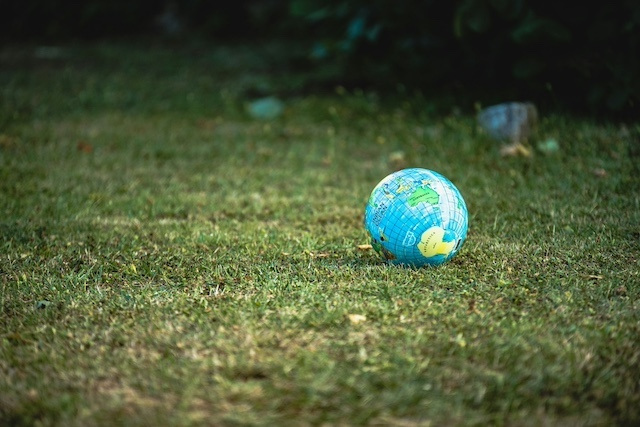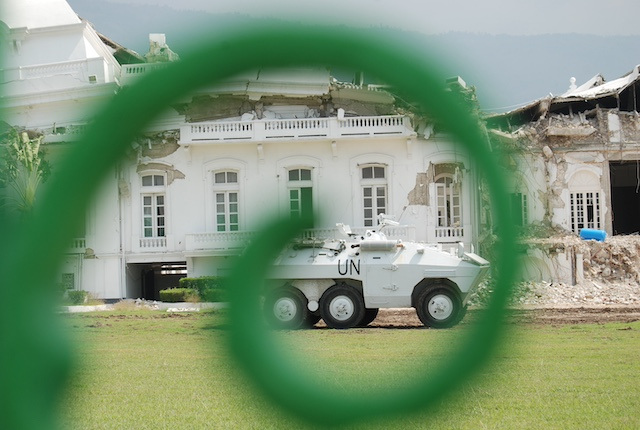Helping Students Deal with Disasters
Posted on January 10, 2025

This weekend marks fifteen years since the destructive 7.0-magnitude earthquake that struck Haiti on January 12, 2010. In remembrance of the tragedy, we're rereading a reflection from Haitian author Lyonel Trouillot, who survived the quake. The anniversary also coincides with devastating forest fires in the United States and ongoing cleanups from many other recent natural disasters across the world. Reading global literature responding to past disasters may help students living through current ones feel less alone as they process these events. This blog post from 2024 offers some trauma-informed strategies for reading and teaching the literature. —Eds.
This fall, Atlantic hurricanes have done severe damage to communities in the Southeast US, as well as to those in other parts of the Americas and Caribbean. What can we learn from others’ past experiences with large-scale disasters? And how can we help students deal with the impact of the storms?
Global literature offers a path forward: stories of similar events in other parts of the world will resonate with students’ emotions, while also being different enough from their lived experiences to offer a sense of safe distance.
As WWB completes our behind-the-scenes work for a collection of Caribbean stories, we thought we’d link to a piece responding to the 2010 Haitian earthquake: Lyonel Trouillot’s essay “January 12, 2010,” translated from French by Linda Coverdale. An older piece, Hirata Toshiko’s poem responding to Japan’s earthquake and tsunami of 2011, also came to mind. The essay is best for students in middle school and up, but the poem is accessible for elementary students.
Trauma-Informed Practices
Before getting into specific teaching ideas for these pieces, we thought we’d share some educators’ recommendations for working with students who have directly experienced a natural disaster or other trauma. Zainab Cheema’s article about teaching after Hurricane Ian (which hit Florida in 2018) includes practical tips and examples of local community/school-based supports that might be similar to those in your area, a sample lesson plan, and several principles that inform the teaching ideas below. (Especially important is the principle of sharing by choice: some students may find comfort in telling their stories of the disaster; others who do not should not be pushed into sharing.)
Melissa Tayles’s “Trauma-Informed Writing Pedagogy,” published in a journal from the National Council of Teachers of English, has a wealth of good advice, including:
- Set realistic expectations for yourself; educators usually aren’t equipped to provide therapeutic “healing” to students, but can offer support and a safe environment.
- Share with students about some of your difficult moments and the strategies you’ve adopted.
- Don’t lower academic expectations for students, but make sure you’re phrasing them in a supportive way that reflects the challenges of the current situation. (E.g., “Your papers are due on the 19th, but if you need to handwrite them because your electricity has gone out, that’s completely fine. Also, we’re keeping the school library open at night so you can work there.”)
Finally, for a deep dive into Trauma-Informed Educational Practices (TIEP), take a look at the University of Portland’s online guide.
Writing About Disaster

In his essay about the 2010 Haitian earthquake, Lyonel Trouillot mentions having “a sense that language is inadequate” when it comes to describing a natural disaster. Perhaps because of this feeling, many writers, including Trouillot, use similes and metaphors in describing those events.
Some of the figurative language that appears in these works compares natural disasters to objects that readers will recognize. For example, in the Japanese poem “Do Not Tremble” (translated into English by Jeffrey Angles), Hirata Toshiko likens the Earth to an “unruly cradle” that trembles like “windblown flowers and / Laundry hanging in the yard.”
Others similes and metaphors make comparisons to things readers likely have not seen; for example, a passage in Trouillot’s essay begins with another cradle simile, then moves into much less familiar territory:
And then, the swaying, slight, barely noticeable. Two seconds of swaying, as gentle as a cradle rocking. Acceleration—and within a few more seconds the room can’t hold still, dashes to the right, the left, right, left. The house gone mad, and the pictures, the books falling, flung violently at the walls by invisible hands.
From a cradle to a “house gone mad,” filled with “invisible hands”: the wild metaphors give the reader a sense of what it is to be inside a world that has suddenly turned alien. Elsewhere, Trouillot compares the earthquake to an “unknown monster,” a “savage artist”—a terrifying, previously unsuspected presence that has taken hold of everything in sight.
In this way, through comparisons to the fantastical as well as the familiar, writers like Lyonel Trouillot and Hirata Toshiko help readers enter into their experiences of disaster. Perhaps students can attempt something similar in their own writing.
Potential Assignments:
- Literary Essay: Do you think the essay/poem was successful in giving readers a sense of what it’s like to be in an earthquake? Which parts resonated with your own experiences?
- Personal Essay: Describe a weather situation you have experienced using at least three similes and/or metaphors. (The situation does not have to be dramatic or disastrous, just one that you remember well!) Try to write descriptions that help readers see, hear, and feel along with you.
Pairs Well with . . .
On WWB Campus:
Several additional pieces from Haiti, also responding to the 2010 earthquake, are posted here on the blog with videos and other informational resources about the event:
- "Why Write? In Haiti, an Author Makes Sense of Disaster," featuring an essay
- "What's the Sound of a City on the Brink?," featuring a poem that could be studied alongside “Do Not Tremble”
- "From Haiti, a Powerful Story of Disaster and Connection, featuring a short story from Lyonel Trouillot's sister Évelyne
Elsewhere:
Two books published in the US also use similes and metaphors to describe weather:
- The Perfect Storm, by Sebastian Junger: a journalist’s account of a weather disaster
- Salvage the Bones, by Jesmyn Ward: a novel about the deadly Hurricane Katrina, which hit New Orleans in 2005
By Nadia Kalman



